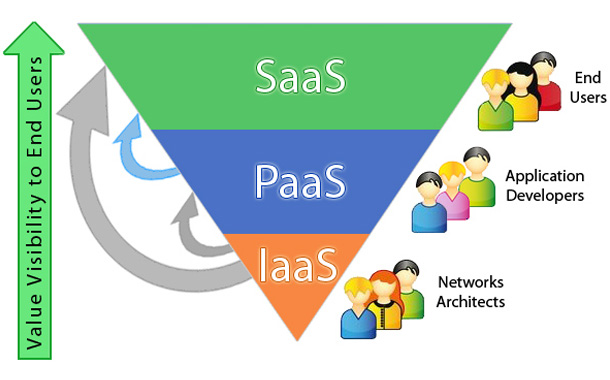Introduction: Businesses and individuals in today’s fast-paced technology landscape have several alternatives for exploiting cloud computing services to fulfill their diverse demands. Among the most common cloud service models are Infrastructure as a Service (IaaS), Platform as a Service (PaaS), and Software as a Service (SaaS). These three service models each have unique features, benefits, and applications, making it critical to understand the distinctions between them in order to make an informed decision about which one best meets your needs.
IaaS: Infrastructure as a Service
IaaS, or Infrastructure as a Service, is the most foundational layer in the cloud computing hierarchy. It provides virtualized computing resources over the internet, including servers, storage, and networking. Here are the key features and differences of IaaS:
Flexibility and Control: IaaS offers a high degree of control and flexibility. Users can choose their operating systems, install software, and configure the infrastructure to suit their specific needs.
Scalability: IaaS platforms allow users to scale resources up or down according to demand, making it suitable for businesses with varying workloads.
Responsibility: While users have control over the infrastructure, they are responsible for managing the operating system, applications, and security.
Use Cases: IaaS is ideal for businesses that require full control over their infrastructure, such as development and testing environments, hosting websites, and running applications.
PaaS: Platform as a Service
Platform as a Service (PaaS) is the next layer up in the cloud computing stack. PaaS provides a development and deployment environment for applications, removing much of the underlying infrastructure management. Here’s what you need to know about PaaS:
Development Focus: PaaS is designed to streamline application development. It provides a platform and tools for developers to build, test, and deploy applications without worrying about the underlying infrastructure.
Automated Scalability: PaaS platforms automatically handle scalability, making it easier for applications to adapt to changing workloads.
Reduced Management: Users can focus on coding and application functionality, as the platform handles many administrative tasks like patching, backups, and security.
Use Cases: PaaS is suitable for software developers and organizations that want to accelerate application development and deployment without getting bogged down by infrastructure management.
SaaS: Software as a Service
Software as a Service (SaaS) is the top layer in the cloud service model, delivering fully functional software applications to end-users over the internet. Here are the defining characteristics of SaaS:
Ready-to-Use Software: SaaS applications are ready to use immediately, without the need for installation or configuration.
Maintenance-Free: The service provider manages all aspects of the software, including updates, security, and data storage.
Subscription Model: SaaS is typically offered on a subscription basis, where users pay for access to the software for a specific period.
Use Cases: SaaS is ideal for businesses and individuals looking to access common applications such as email, customer relationship management (CRM), and productivity tools like Microsoft 365.
Comparing the Models
To summarize, let’s compare these three cloud service models based on key factors:
Control: IaaS offers the most control, followed by PaaS, while SaaS provides the least control but the most convenience.
Scalability: IaaS and PaaS both allow for scalability, but PaaS automates this process to a greater extent. SaaS scalability is limited to the features provided by the software.
Responsibility: IaaS users have more responsibilities, while PaaS and SaaS shift many administrative tasks to the service provider.
Use Cases: The choice between these models depends on your specific needs. IaaS is for infrastructure control, PaaS is for application development, and SaaS is for accessing ready-to-use software.
Conclusion
Understanding the differences between IaaS, PaaS, and SaaS is crucial when making decisions about cloud services. Each model offers distinct features and advantages, catering to different use cases and requirements. By assessing your organization’s specific needs, you can make informed choices that align with your business goals, whether you seek control, simplified development, or convenient access to software. The cloud computing landscape continues to evolve, and staying informed about these models will enable you to harness the power of the cloud to its fullest extent.
What are the main differences between IaaS, PaaS, and SaaS?
This question aims to provide a high-level overview of the key distinctions between these three cloud service models, making it easier for individuals or businesses to choose the right one for their needs.
How do I decide which cloud service model to use for my project or organization?
Many people grapple with the decision of whether to use IaaS, PaaS, or SaaS. This FAQ helps guide them in assessing their specific requirements and aligning them with the appropriate cloud service model.
What are some real-world examples of IaaS, PaaS, and SaaS applications?
Offering concrete examples can help individuals understand how these cloud service models are utilized in various scenarios. Real-world use cases illustrate the practical applications of each model.
Do these cloud service models complement each other, or do I have to choose only one for my project?
Some projects may benefit from using a combination of these cloud service models. This question addresses the possibility of using multiple models in a single project to harness their respective advantages.
Are there security and data privacy concerns associated with IaaS, PaaS, and SaaS?
Security is a paramount consideration when working with cloud services. This question explores the security and data privacy implications of each model, helping users understand the associated risks and precautions.



